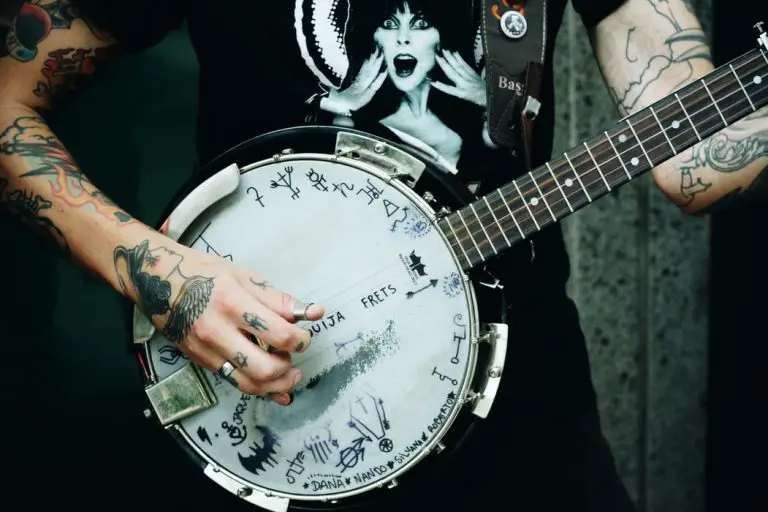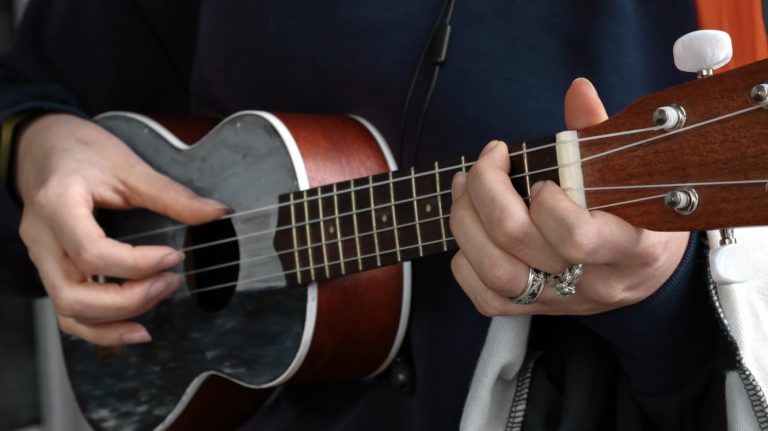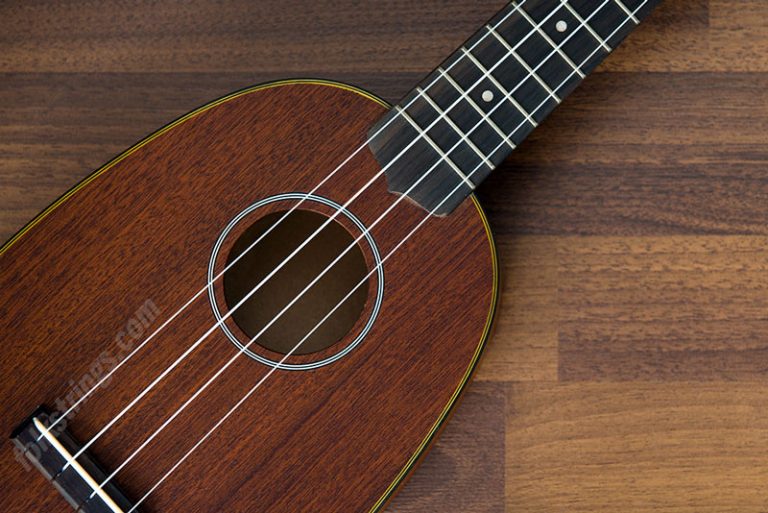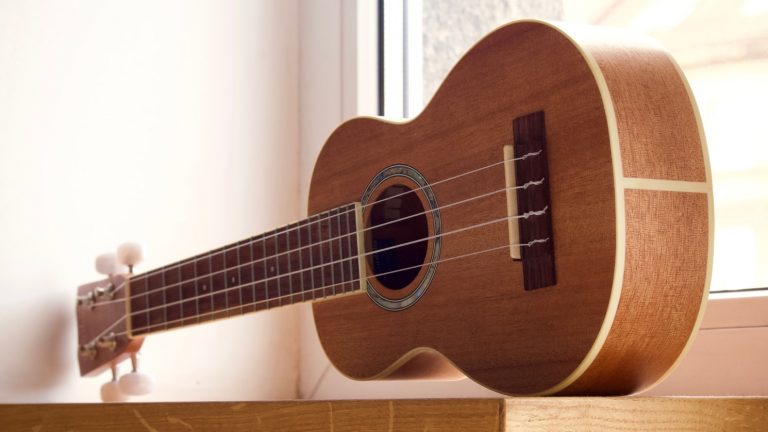What Are Some Good Ukulele Songs for Beginners? – Easy Strumming Hits to Start Playing
Folkstrings.com is reader-supported. When you buy through links on our site, we may earn a small commission.
Learning to play the ukulele can be a rewarding and enjoyable endeavor.
For beginners, the journey often starts with simple songs that are not only easy to learn but also serve as a foundation for developing fundamental skills.
The ukulele, with its soft tone and small size, is an ideal instrument for newcomers looking to quickly play complete songs.
Easy ukulele songs typically consist of a few basic chords and a simple strumming pattern, making them accessible even for those who have never played an instrument before.
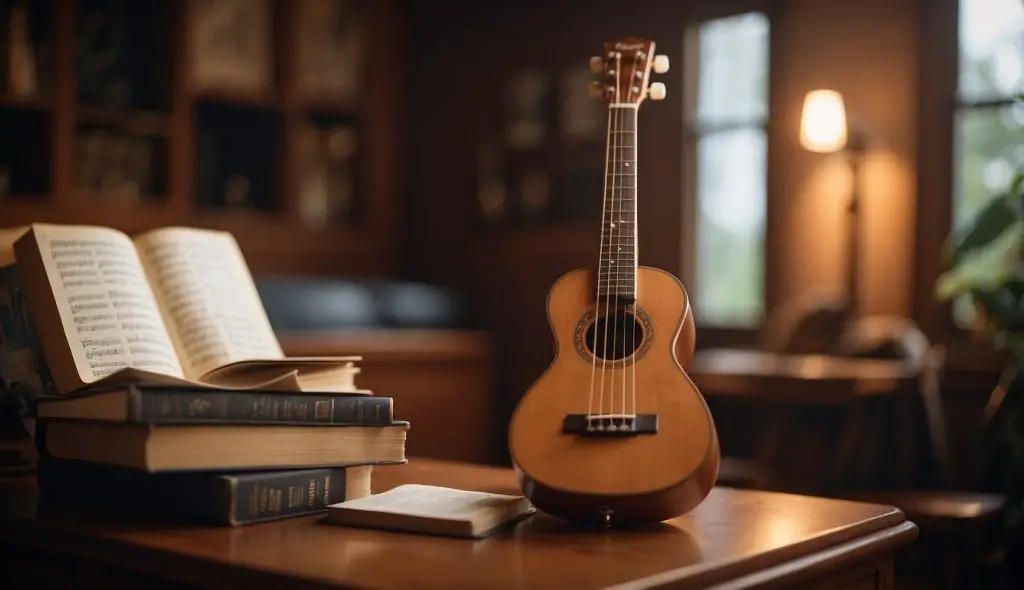
As a beginner, the first step to making music with your ukulele is to get comfortable with the basic chords. These chords allow you to play a vast array of songs and are the building blocks of your playing expertise.
Once you’ve mastered a select group of chords, the next step is to practice strumming and maintaining rhythm.
The ukulele shines in its simplicity, making it a perfect instrument for experimenting with different strumming techniques and rhythms that bring a song to life.
With regular practice, you can gradually build your repertoire and confidence, starting with straightforward and well-loved tunes that have stood the test of time.
Key Takeaways
- Learning the ukulele starts with simple songs that bolster basic playing skills.
- Mastering a few basic chords opens up a wide catalogue of songs for beginners.
- Consistent practice in strumming and rhythm is key to bringing ukulele songs alive.
Choosing Your First Ukulele
When starting on the journey of learning the ukulele, picking the right instrument is essential as it affects your learning experience and the progress you make. I’ll guide you through the types of ukuleles available and what specific features to consider for a beginner ukulele.
Types of Ukuleles
There are mainly four sizes of ukuleles: Soprano, Concert, Tenor, and Baritone.
- Soprano: This is the smallest and the most traditional size, with a bright, light sound. It’s ideal for beginners due to its compact size and ease of handling.
- Concert: Slightly larger than the soprano, it has a fuller sound and a bit more room between frets, which can be helpful for those with larger fingers.
- Tenor: Offering a deeper tone and louder volume, this size is great for performers or if you’re looking for a richer sound.
- Baritone: The largest ukulele, tuned differently from the other types, provides a sound closest to a classical guitar.
What to Look for in a Beginner’s Ukulele
Quality and Budget:
- Look for a ukulele made of real wood rather than laminate or plastic if your budget allows, as this affects the sound quality.
- My recommendation for beginners is to aim for a price point around $50-$100. This range typically ensures a decent quality instrument without breaking the bank.
Playability:
- The action, or height of the strings above the fretboard, should be low to ease playability and avoid finger soreness.
- Ensure the ukulele stays in tune. Test the tuning pegs to see if they hold the tune, as frequent re-tuning can be discouraging when you’re just starting out.
Song Tutorials and Tabs
I want to share a progression path for any ukulele beginner that’s eager to expand their repertoire. From easy strums to more intricate chords, these tutorials and tabs will get you playing and enjoying music in no time.
Easy Songs to Begin With
When I first started playing the ukulele, I found that some songs were more accommodating for my novice fingers. Tabs for these songs often involve simple chord progressions and are perfect for practice.
- “Three Little Birds” by Bob Marley: This iconic song is my go-to recommendation with its cheerful rhythm and repetitive structure. It features basic chords like A, D, and E.
- “Love Me Do” by The Beatles: With a familiar melody and straightforward chords such as G, C, and D, it’s a fun song that helped me boost my confidence.
Tabs for beginners:
| Song | Chords Used | Strumming Pattern |
|---|---|---|
| “Riptide” by Vance Joy | Am, G, C | D – DU – UDU |
| “Let It Be” by The Beatles | C, G, Am, F | D – D – D – D |
| “Love Yourself” by Justin Bieber | C, G, Am, D | D – DU – UDU |
These tablatures focus on the use of open chords, which are easier to transition between and master for beginners.
Progressing with More Complex Songs
Once comfortable with a few chords and strumming patterns, you can move on to songs that incorporate a mix of open chords and more complex ones like E7 or A7.
- “Hotel California” by The Eagles: Learning this song was a milestone—it challenged me with new chords but the payoff was immense in terms of skill development.
- “Somewhere Over the Rainbow” by Israel Kamakawiwo’ole: This version of the classic song integrates both picking and strumming, introducing me to fingerstyle play.
Tabs for intermediate players:
| Song | Chords Used | Strumming Pattern |
|---|---|---|
| “Counting Stars” by OneRepublic | Am, C, G, F | D – DU – UDU – UDU |
| “Brown Eyed Girl” by Van Morrison | G, C, D, Em | D – DUDU – D – DUDU |
| “Hallelujah” by Leonard Cohen | C, Am, F, G, E7 | D – DU – UD – DUDU |
Strumming and Rhythm Techniques
I know that getting the hang of strumming and rhythm is essential for any beginner ukulele player. These techniques are the heart of your musical expression, so let’s dive into mastering the strumming pattern and then work on some rhythm and timing exercises.
Mastering the Strumming Pattern
When I first started learning the ukulele, I discovered that strumming patterns can make or break a song. To get started, familiarize yourself with a few basic strumming patterns. Here’s a simple one to practice:
- Down-Up Pattern: Strum down with the nail of your index finger, then up with the pad of your finger.
| Strum | Direction | Counts |
|---|---|---|
| D | Down | 1 |
| U | Up | & |
| D | Down | 2 |
| U | Up | & |
Repeat this pattern in a steady rhythm to keep a consistent tempo. Remember to start slow and gradually increase your speed as you become more comfortable.
Rhythm and Timing Exercises
A good rhythm and timing foundation are just as vital as the notes you play. To help with this, I practice with a metronome to ensure my timing is on point.
Start by setting a metronome to a slow tempo and play the down-up strumming pattern along with the beat. Increase the speed as you gain confidence.
Here’s a quick exercise I often do:
- Set the metronome to 60 BPM (beats per minute).
- Strum down on each click for one minute.
- After you’re comfortable, add an up strum between clicks.
Basic Ukulele Chords for Beginners
Before diving into playing songs, I know it’s essential to get comfortable with some basic ukulele chords. These chords are the building blocks for most ukulele songs and will help you play with ease.
Understanding Chord Diagrams
To learn ukulele chords, I use chord diagrams, which are simple illustrations that show me where to place my fingers on the fretboard. Each diagram represents the ukulele neck as if I’m looking at it head-on. The vertical lines represent the strings—G, C, E, A from left to right—and the horizontal lines represent the frets. A dot on the diagram indicates where I should place my finger.
Common Beginner Chords
Here’s a list of some common ukulele chords that I started with, which are perfect for beginners:
- C Chord: Place your ring finger on the third fret of the A-string.
- G Chord: Place your index finger on the second fret of the C-string, your ring finger on the third fret of the E-string, and your middle finger on the second fret of the A-string.
- F Chord: Place your index finger on the first fret of the E-string and your middle finger on the second fret of the G-string.
- A Chord: Place your index finger on the first fret of the C-string and your middle finger on the second fret of the G-string.
- E Chord: This is a more challenging chord for beginners, as it’s a barre chord. Place your index finger across all strings on the second fret, your ring finger on the fourth fret of the G-string, middle finger on the fourth fret of the C-string, and little finger on the fourth fret of the A-string.
- D Chord: Place your index, middle, and ring fingers on the second fret of the G, C, and E-strings, respectively.
Practicing and Building Your Repertoire
A solid practice routine is crucial for growth on the ukulele, and building a repertoire of songs that you enjoy and are comfortable playing will keep you motivated. Let’s dive into setting specific practice goals and expanding your song list in a way that feels rewarding and fun.
Setting Practice Goals
I always start my practice sessions with clear objectives. This might be mastering a new chord or perfecting a strumming pattern within a particular song. Specific goals help me stay focused and measure my progress. For example:
- Monday: Practice C, G, Am, and F chords.
- Tuesday: Learn strumming pattern for “Riptide” by Vance Joy.
- Wednesday: Combine chords and strumming pattern.
- Thursday: Play “Riptide” without stopping.
- Friday: Record my playing and listen for timing and quality.
By breaking down my practice into these achievable tasks, I maintain my motivation and see tangible progress.
Expanding Your Song List
Once I’m comfortable with a few songs, I start expanding my repertoire. I explore different genres to find what resonates with me and look for songs that use chords I’m already familiar with. Folk and pop genres are great for beginners because they often have simple chord progressions.
To expand my repertoire, I:
- Look for songs by artists I admire, such as Israel Kamakawiwoʻole or Grace VanderWaal.
- Select a mix of slow and fast-paced songs to develop diverse playing skills.
- Keep a list of dream songs that are currently too difficult but serve as long-term goals.
Frequently Asked Questions
In this section, I’ll share answers to common queries about beginner ukulele songs, focusing on easy sing-along tunes, chords, and where to find song tabs.
What are some easy sing-along songs that I can learn on the ukulele?
Songs like “You Are My Sunshine” and “Riptide” by Vance Joy are great for beginners. They have simple lyrics and chord progressions, which make them easy to sing along to as you play.
Can you recommend simple ukulele songs that use the C chord for beginners?
Certainly! “Three Little Birds” by Bob Marley and “Let It Be” by The Beatles prominently feature the C chord and are excellent for beginners to start with.
Where can I find tabs for beginner-friendly ukulele songs?
Ukulele tabs for beginners can be found on websites such as Ukulele Tabs and Ultimate Guitar. These sites offer a range of songs with simple chord diagrams and tablature.
Are there any popular ukulele songs I can learn as a beginner?
Absolutely! “Somewhere Over the Rainbow” by Israel Kamakawiwo’ole and “I’m Yours” by Jason Mraz are popular choices that I find beginner-friendly.
Which four chords are considered the easiest for ukulele beginners?
The four easiest chords to start with on the ukulele are C, G, Am, and F. Many songs can be played using just these chords.
What are the first basic steps I should follow when learning to play the ukulele?
My advice for beginners is to start by learning the C, G, Am, and F chords, as well as basic strumming patterns. Practice changing between these chords smoothly to build a solid foundation.
Author Profile
-
Daniel Johnstone is an English writer with a love for stringed instruments from around the world.
He shares his love for these instruments through his writing for folkstrings.com, a website dedicated to all things related to folk string music.
Daniel's passion for music started at a young age, and he has since become an accomplished musician, playing guitar, cavaco, and recently, the harp.
His dedication to learning and sharing his knowledge of stringed instruments is evident in his insightful and engaging blog posts. Whether you're a seasoned musician or a beginner, Daniel's writing is sure to inspire and entertain you.
When he's not playing music or writing, you can find Daniel exploring new instruments and seeking out new sounds to share with his readers.
Latest entries
 AutoharpApril 4, 2024What Is the Autoharp Made Of: Exploring Its Materials and Craftsmanship
AutoharpApril 4, 2024What Is the Autoharp Made Of: Exploring Its Materials and Craftsmanship AutoharpApril 4, 2024Is Autoharp Easy to Play? Unveiling the Truth for Beginners
AutoharpApril 4, 2024Is Autoharp Easy to Play? Unveiling the Truth for Beginners AutoharpApril 4, 2024What Is an Autoharp Worth? Your Guide to Pricing and Value
AutoharpApril 4, 2024What Is an Autoharp Worth? Your Guide to Pricing and Value AutoharpApril 4, 2024Are Autoharp and Zither the Same Thing? Unraveling String Instrument Myths
AutoharpApril 4, 2024Are Autoharp and Zither the Same Thing? Unraveling String Instrument Myths
Affiliates:
This post may contain affiliate links that at no additional cost to you, the site may earn a small commission. We only recommend products we would use ourselves and all opinions expressed on this site are our own.
Accuracy Advice:
While we strive to provide up-to-date and accurate information, the content in this article may not reflect the most current research or medical guidelines. We encourage readers to do further research and consult with professionals for more personalized advice.
Our Recommendations:
The products and services mentioned in any of our articles are recommended based on our independent research and personal experience. We are not sponsored by any company. We aim to suggest products and services we believe are of high quality and could be beneficial to our readers.


